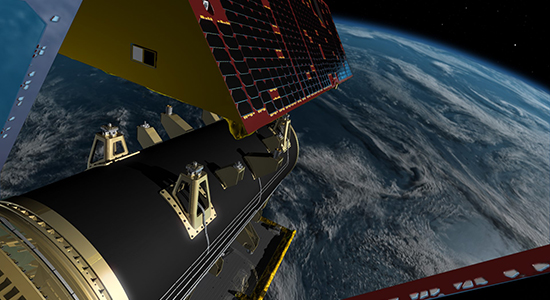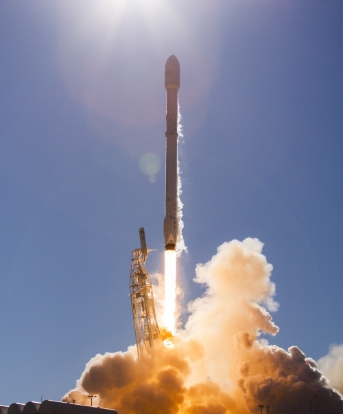The Falcon 9 will launch GRACE-FO from SLC-4E down an initial flight azimuth of 180.1 degrees from true north (south-southwest). The boost-phase trajectory is designed to place the Falcon 9 upper stage, along with the GRACE-FO and Iridium satellites, directly into an approximately 305 mile (490-kilometer) circular orbit by the time of the first cutoff of the Falcon 9 Second-Stage engine (SECO-1). The nominal altitude of the injection orbit for GRACE-FO was chosen to match that of GRACE.
The Falcon 9’s Merlin first-stage engine start sequence begins approximately three seconds prior to liftoff. After liftoff, the launch vehicle will travel through maximum dynamic pressure (max Q). The nine first-stage engines burn for approximately two minutes and 45 seconds before being commanded to shut down at Main Engine Cutoff (MECO). Separation of the Falcon 9’s first and second stages occurs seconds later, followed by ignition of the second-stage engine for second-engine start 1 (SES1), which burns until reaching the injection orbit. During the second-stage burn, the payload fairing, or launch vehicle nose cone, will separate into two halves, like a clamshell, and fall away.

Artist's concept of GRACE-FO separating from the launch vehicle
Image credit: NASA/JPL-Caltech
After separating from the first stage and completing its ascent with the orbit insertion burn, the second stage pitches down 30 degrees to its separation attitude for GRACE-FO and rolls so that one of the GRACE-FO satellites is on the Earth-facing side of the launch stack and the other on the opposite side is facing space.
Approximately 11.5 minutes after liftoff, a separation system on the re-ignitable second stage will deploy the twin GRACE-FO satellites in nearly the same nominal orbit. The separation impulses are within 20 milliseconds of each other and push the two spacecraft in opposite directions, with the only differences being that the separation mechanisms will have pushed the two satellites crossways in opposite directions by 0.8 feet (0.25 meters) to 1 foot (0.30 meters) per second each, resulting in slight relative velocity differences and magnitudes. Thus one of the GRACE-FO satellites will be pushed up into a larger, higher orbit that is slower on average, and the other will be pushed down into a smaller, lower orbit that is faster on average.
Separation occurs over the Pacific Ocean at about 17.5 degrees North latitude, 122.6 degrees West longitude. VAFB will confirm a successful separation using downlinked telemetry data from the upper stage. The first data from the spacecraft are expected to be received through the first pass over NASA’s tracking station at McMurdo, Antarctica. The satellites will be in range of the McMurdo station about 23 minutes after separation and within range of the Alaska Satellite Facility tracking station about 45 minutes later, providing a good chance of acquiring early telemetry data for mission operations.
After separation of the GRACE-FO satellites, the Falcon 9 second stage will coast before re-igniting its engine (SES2) to take the Iridium NEXT satellites to a higher orbit, where they will be deployed, one by one.


